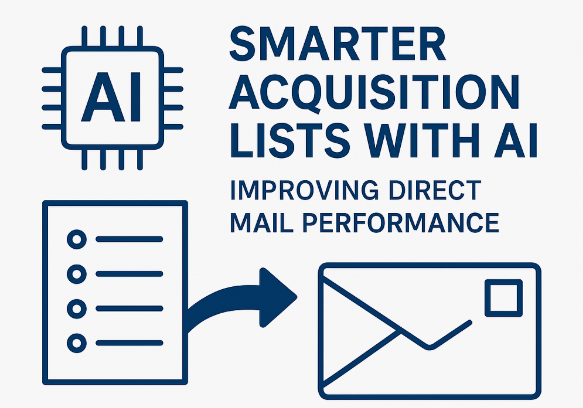AI in Direct Mail: Smarter Acquisition Lists
Streamworks Blog

Your list isn’t just important in direct mail—it’s everything. No matter how compelling your creative or offer is, if your mail doesn’t reach the right audience, it won’t perform. Managing multiple recipient addresses efficiently is crucial for direct mail campaigns, making effective mailing solutions essential for success. That’s why more marketers are turning to artificial intelligence (AI) and predictive modeling to build smarter acquisition lists—and they’re seeing better results because of it.
Introduction to Direct Mail Marketing
Direct mail marketing remains a powerful tool for businesses aiming to reach and engage their target audience in a meaningful way. By sending physical mail—such as letters, postcards, or brochures—directly to customers or prospects, businesses can cut through digital noise and make a tangible impression. A well-planned direct mail campaign allows companies to stand out from competitors and achieve their marketing goals, especially when combined with data collected from existing customers.
In today’s landscape, direct mail marketing is not only cost effective but also highly adaptable. By integrating AI-powered tools, businesses can analyze purchasing behavior, identify patterns, and create personalized messaging that resonates with recipients. This data-driven approach enables marketers to tailor their marketing efforts, ensuring that each mail piece is relevant and engaging. As a result, businesses can increase response rates, maximize their marketing budget, and build stronger relationships with their audience—all while leveraging the unique advantages of mail as a marketing channel.
Traditional List Building Isn’t Enough Anymore
Acquisition lists used to be built on broad demographics like age, income, geography, or homeownership. Traditionally, demographic data was used to segment audiences for direct mail, allowing marketers to tailor messaging to general groups. Now, AI enables deeper analysis beyond basic demographic data, uncovering more precise targeting opportunities. These lists, often pulled from large compiled databases, cast a wide net—sometimes too wide. The result? Wasted impressions, higher costs, and lower response rates.
Today’s consumers and donors expect more personalized, relevant outreach. That means list strategies need to evolve—AI is leading that evolution.
AI + Predictive Modeling = Precision Targeting
AI takes list building beyond basic demographics by analyzing massive volumes of data to uncover patterns, predict behaviors, and identify high-value prospects. By enabling marketers to focus on high quality leads, AI improves sales efficiency and boosts overall conversion rates.
Many of the top data providers and compilers—like Experian, Wiland, Epsilon, and others—are now using predictive modeling to create smarter acquisition segments. Here’s how it works:
1. Lookalike Modeling Based on Real Performance
Data companies analyze your existing customer or donor file to identify key traits and behaviors of your best responders. Then, using machine learning algorithms, they build a predictive model that scores millions of potential contacts based on how closely they match those traits. This “lookalike” model helps you mail only to those who behave like your top performers—not just those who look like them on paper. By targeting the right audience, this approach supports overall business growth and customer acquisition efforts.
2. Response Propensity Scoring
Each contact in the database is assigned a score predicting how likely they are to respond to a particular offer or campaign. These scores are generated using AI tools that analyze transaction history, campaign performance, lifestyle indicators, and other behavioral data points. This lets you prioritize high-propensity names while suppressing low-value ones—maximizing your budget and improving ROI. As a result, your direct mail campaigns can achieve a significantly higher response rate compared to less targeted approaches.
3. Intent & Lifestyle Signals
Some advanced database companies also integrate online behavioral data, like search habits and content consumption, into their modeling. This allows them to understand where a prospect is in their decision-making journey—so you can time your mail drop to meet them at the right moment. These insights help marketers decide the most effective timing and messaging for their campaigns.
4. Campaign-Level Learning
Predictive models aren’t static. Each campaign generates new data, which feeds back into the model to make it brighter. Over time, your acquisition efforts become more refined, efficient, and successful. This iterative process ensures maximum impact from each direct mail campaign.
Measuring and Optimizing Direct Mail Campaigns
To ensure the success of any direct mail campaign, it’s essential to measure and optimize performance at every stage. Tracking key metrics such as response rates, conversion rates, and return on investment (ROI) allows businesses to determine the effectiveness of their marketing efforts. By analyzing data collected from each campaign, marketers can uncover valuable insights and identify areas for improvement.
AI-powered tools make it possible to process vast amounts of data quickly, providing data-driven insights that help businesses refine their strategies. Predictive analytics can identify the most promising leads, enabling marketers to tailor their messaging and focus on recipients most likely to respond. This approach not only increases response rates but also ensures that marketing resources are allocated efficiently. By continually measuring results and leveraging AI to optimize campaigns, businesses can achieve greater success and drive better outcomes from their direct mail marketing initiatives.
Best Practices for Direct Mail Marketing
Creating a successful direct mail campaign starts with targeting the right audience and delivering a message that resonates. Businesses should use high-quality mailing lists and leverage lookalike modeling to reach new customers who share characteristics with their best existing customers. Personalizing content and crafting a clear, compelling message are essential for capturing attention and driving action.
Cost effectiveness is also key—considering factors like postage rates and selecting postal routes can help maximize reach while staying within budget. AI algorithms can identify patterns in customer behavior, allowing marketers to focus on the most relevant recipients and tailor particular offers that appeal to their interests. By following these best practices, businesses can run efficient, cost-effective direct mail campaigns that deliver higher response rates and meaningful results.
Common Mistakes in Direct Mail Marketing
One of the most common mistakes in direct mail marketing is casting too wide a net and targeting the wrong audience. Sending mail to a broad, untargeted list can lead to wasted resources and lower response rates. Instead, businesses should focus on building targeted mailing lists and using data-driven insights to inform their marketing decisions.
Another frequent error is failing to personalize content, which can make messages feel generic and less engaging. Relying on low-quality mailing lists or neglecting to track response rates can also hinder a campaign’s success, making it difficult to measure what’s working and what isn’t. By avoiding these pitfalls and focusing on targeted, personalized, and data-driven strategies, businesses can create direct mail campaigns that truly connect with their audience and drive measurable results.
Why It Matters for Your Direct Mail Campaigns
When you combine AI with predictive modeling, your acquisition list becomes more than just a list—it becomes a strategic asset. Benefits include:
-
Higher response rates
-
Lower cost per acquisition
-
More efficient use of print and postage
-
Better campaign ROI
-
Improved personalization when paired with variable data printing
-
Building an effective mailing list by analyzing existing clients over time, which enhances branding and messaging efforts
Future of Direct Mail Marketing
The future of direct mail marketing is bright, thanks to the integration of AI-powered tools and advanced technologies. As businesses continue to embrace data-driven insights and predictive analytics, direct mail campaigns will become even more personalized and targeted. Rather than being replaced by digital marketing, direct mail is now complemented by channels like email marketing, creating a multi-touch approach that increases response rates and engagement.
With ongoing advancements in AI and data analysis, businesses can expect to see new ways to reach and engage their target audience, making direct mail an even more powerful tool in their marketing arsenal. By adopting the right strategy and leveraging innovative tools, companies can ensure that their direct mail marketing efforts remain effective, relevant, and results-driven well into the future.
Want Smarter Acquisition Lists? Streamworks Can Help.
At Streamworks, we partner with leading data providers to build AI-powered acquisition lists that work harder and smarter. Whether you're acquiring new donors, customers, or members, we'll help you identify the right audience, deliver the right message, and generate better results.
Let's discuss how predictive modeling and smart data targeting can elevate your next direct mail campaign.


.jpg?width=352&name=shutterstock_1552272761%20(1).jpg)

